Worms most commonly occur in preschool and elementary school-age children. Where do worms come from? The main cause of helminthic invasion in children is poor hygiene. Toddlers don’t always wash their hands, they like to put their fingers in their mouths, chew their nails, eat unwashed fruits and vegetables. The development of a helminthic invasion occurs when a person's immunity is weakened. Children’s immune systems are still developing, unable to cope with a large number of foreign agents. In children, the signs of worms are similar to the symptoms of poisoning or gastrointestinal disease.
Why are worms dangerous to a child's body? They damage the internal organs, suck up nutrients, cause inflammation. The toxins secreted by the helminths adversely affect the baby’s nervous system. You can remove worms using traditional and traditional medicine.
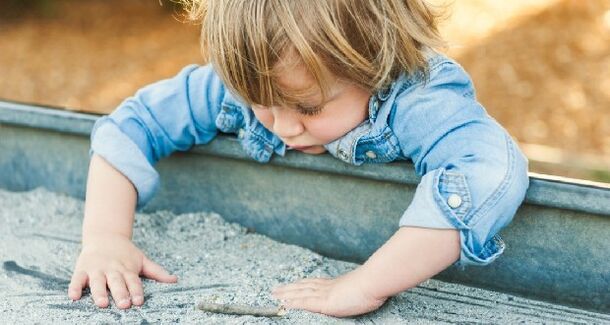
Types of helminthiasis in children
In children, helminths appear quite often, especially in preschool. The risk of infection is always high. The child can get an infection in kindergarten, on a playground, in contact with animals. In addition, children often neglect to wash their hands after using the toilet before eating.
What are worms? Worms are a huge group of parasitic worms. They can live in the gut, liver, airways, and some can affect the heart and brain. The main types of worms in children are:
- Roundworms - the most populous class of human parasites, including dumplings, roundworms, hookworms, trichinella.
- Tapeworm - the class includes bovine and porcine tapeworms (tapeworms), echinococcus.
- Trematodes are digenetic rashes, including schistosomes, opisthorchis, rashes (liver and cat).
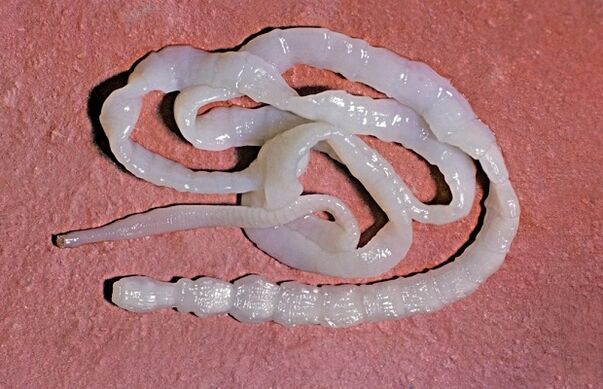
In addition, parasitic diseases are caused by protozoa (protists) - unicellular; in the human gut parasitizes Giardia or amoeba.
Diseases caused by parasites in children have varying degrees of danger but have similar symptoms. The vast majority of nematodes parasitize in the gastrointestinal tract and are found in the contents of the duodenum and feces. The food source of worms is digested food (most often carbohydrates), sometimes blood. The symptoms of helminthiasis in children are similar to those of eating disorders or gastrointestinal disorders.
The most common types of helminthiasis in children
Children are much more prone to worm infection than adults. The most common helminthiasis in children is:
- Enterobiasis (pinworm infection).
- Ascariasis (ascaris invasion).
- Giardiasis (giardia invasion).
Pinworms live only in the intestines. Migratory nematode larvae enter the airways, liver, and heart. Giardia often causes liver and gallbladder diseases, although they are unable to survive in these organs. Are these diseases contagious?
Enterobiasis is spread from person to person through handshake and contact with household items used by the patient.
Ascariasis and giardiasis can spread from the baby to other family members under certain circumstances.
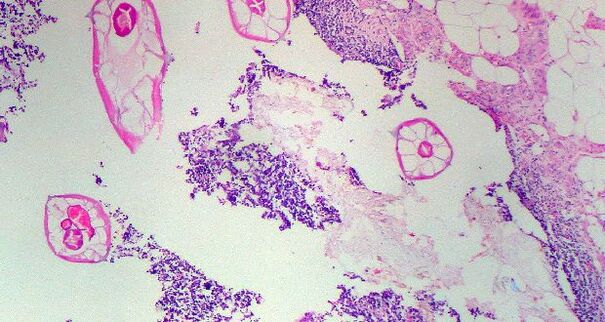
Enterobiasis
The main cause of fungal infection is dirty hands. In addition, parasitic eggs can get into a baby’s body if they eat poorly washed fruit. Signs of infection caused by worms appear after 3-4 weeks from the time of infection. A characteristic symptom of enterobiasis is itching of the anus, which appears during sleep. Uncomfortable feelings are caused by the movement of female worms that crawl out to lay eggs. In the event of a severe invasion, you can see the worms in the child's stool with the naked eye.
When the baby scratches the anus and then puts his hand in his mouth (which often happens in young children), he becomes re-infected. Therefore, during the treatment of helminthiasis, children should be monitored to wash their hands regularly and eat only well-processed foods.
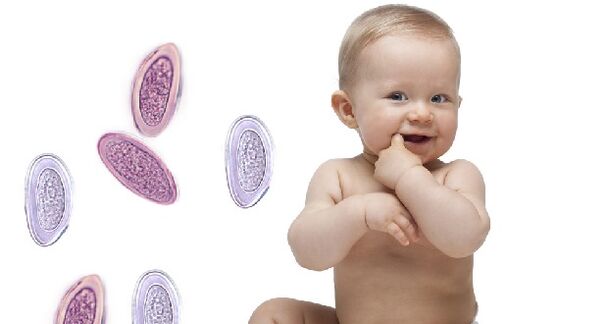
Ascariasis
Infection with nematodes occurs on unwashed products, inadequately cooked meat, by contact with animals. Parasites enter the baby's body in the form of eggs and larvae. The eggs develop in the intestines and the larvae begin to migrate through the blood and lymphatic channels. They get to the liver, the right ventricle of the heart, the lungs. These organs are supplied regularly and with plenty of oxygen, which is so necessary for the larvae to become adults. From the lungs, the larvae enter the bronchi, trachea, cough, and enter the stomach with saliva. The cycle of movements lasts until the larva grows.
In children, worms can cause an intense cough in addition to the typical symptoms. Heminthiasis in children is detected using a coprogram and specific blood tests.
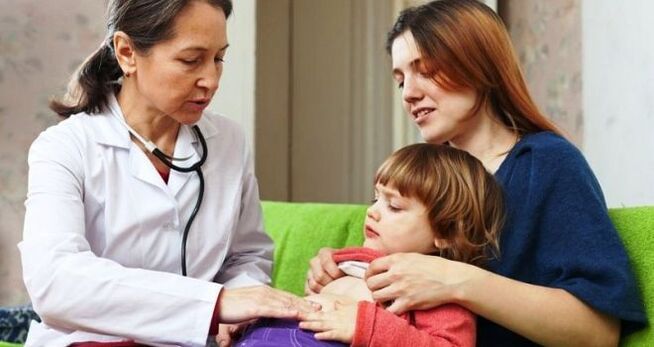
Giardiasis
Giardiasis in a child develops when more than 10 cysts enter the body. Cysts are immobile, resistant to environmental conditions, the life form of the lamblia, from which individuals capable of reproduction develop under favorable conditions. Mobile protists can only live in conditions that occur only in the human small intestine.
Developmental stages of the Giardia invasion in humans:
- Cysts from the oral cavity enter the stomach and then the duodenum. The protective capsule is destroyed, two Giardia are released.
- Giardia eats simple carbohydrates and multiplies in half by the longitudinal division of the cell.
- Some of the parasites end up in the colon, where they can only exist in the form of cysts.
- During defecation, the cysts come out and enter the external environment.
Giardia cysts are found in water, vegetables, fruits, meats, and household surfaces. They are very tough and hard to ruin with traditional detergents. The risk of human-to-human transmission is low.
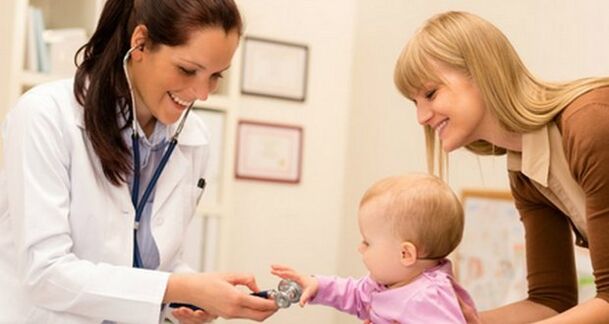
Typical symptoms of helminthiasis in children
The first signs of worms appear 2 to 4 weeks after infection. In children, the worm infection can occur in acute or latent form. If the parasite population is small, the baby may not feel uncomfortable.
The main symptoms of worms in children are:
- Abdominal pain of various localizations and intensities, manifested by seizures.
- Stool disorders, diarrhea and constipation.
- Nausea, vomiting.
- Decreased or, conversely, brutal appetite.
- Intestinal dysbacteriosis.
- Energy loss, dizziness.
- Sleep disorders.
- Dermatitis.
- Pale skin, blue circles under the eyes.
- Urinary incontinence may occur in girls.
Dermatitis (skin rash, redness, itchy skin) is the result of an allergic reaction to toxins emitted by helminths. Harmful substances also affect the condition of the nervous system. Kids look tired, irritable, whimsical.
Acute infection in children is accompanied by symptoms of helminths - fever, vomiting, diarrhea.

Examination of childhood helminths
How to identify worms in a child? Worm infection in children is difficult to determine based on the clinical picture. The symptoms of different helminthiases are similar. Worms are detected using proven and new laboratory diagnostic methods.
- Histological analysis of the stool allows the presence of helminth eggs in the stool to be checked.
- Microscopic examination of the scraping from the anus (helps to detect enterobiasis).
- Analysis of duodenal contents. The duodenum contains worms or protozoa.
- General blood test with leukocyte formula. Indirect signs of the presence of worms are increased levels of eosinophils and anemia.
- Serological tests for antibodies to helminthicigenesis.
- Analysis by polymerase chain reaction (PCR).
PCR is the most reliable and sensitive method for diagnosing helminthic invasions. Blood, faeces, scraping suitable for analysis. The assay determines the presence of foreign DNA in a biological sample. The efficiency of the histological coprogram is less than that of PCR and ELISA.
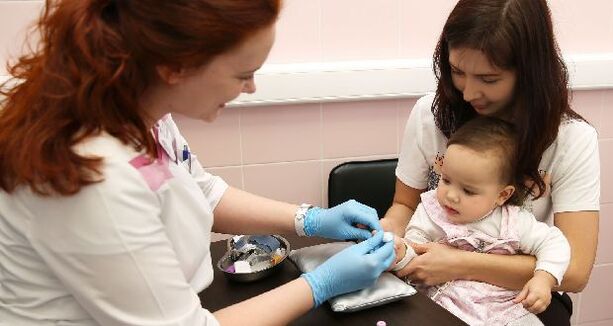
Principles of treatment of helminthic invasion
How to get rid of worms in children? The method of treatment depends on the type and extent of helminthic invasion. Helminthiasis is usually treated conservatively (without surgery), but surgery is performed to remove echinococcal cysts.
The treatment of worms in children consists of several stages:
- Preparing the body for treatment.
- In fact, therapy, taking anthelmintics.
- Recovery of the body after illness and medication. It is necessary to normalize the function of the nervous system, increase immunity, get rid of intestinal dysbacteriosis.
The duration of treatment is usually about three months. Before starting therapy, you need to determine exactly if your child has worms. Treatment is prescribed and monitored by a doctor.

Medication for helminthiasis in children
The integrated approach helps to completely cure any variant of helminthiases without damaging the body. You can use certain medicines to treat worms in a child:
- Anthelmintic drugs. These include antiparasitic drugs that differ in spectrum and principle of action. It is appointed depending on the type of invasion. It will be more comfortable for the baby to take the medicine in the form of a suspension.
- Sorbents. It binds toxins and accelerates the removal of worms from the body. Sorbents should only be taken in strictly defined doses, otherwise severe indigestion may occur.
- Antiallergic agents. It helps relieve the symptoms of allergies to intestinal worm waste.
- Hepatoprotectors. Assignment during the recovery period. It helps to normalize liver function.
- enzyme preparations. Restoration of normal digestion.
In the treatment of enterobiasis, the patient also requires enemas. If your baby is prone to constipation, your doctor will prescribe baby laxatives. It is important to ensure regular stools so that parasites and toxins leave the body. It is impossible to take any medication uncontrollably as there is a possibility of side effects.
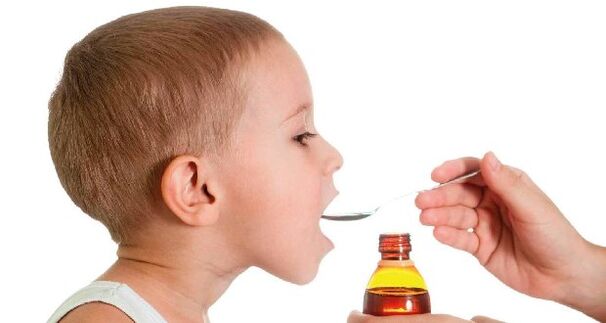
Traditional medicine against worms
Conventional medicine is not desirable for the treatment of helminthiasis in children. They do not destroy worms and do not help remove them from the body. Folk remedies can only be used in combination with medication.
How to remove worms from a child by folk methods? Here are some of the most common recipes:
- Pumpkin seed. It contains components that interfere with the normal functioning of worms, removing toxins. The peeled seeds (100 g) were crushed and poured into olive oil (100 ml). The tincture is given to the child before meals (three hours) for three days. The treatment is repeated after 2 days. Pumpkin seeds can be cooked in milk (15 seeds in 1 glass). The medicine is given to the baby to drink before lunch.
- Garlic mixture. A few cloves of garlic (2-3) should be rubbed on a fine grater, stirring smoothly with a small amount of water. For a small child, the garlic cooked is mixed with a spoonful of milk or orange juice and given to drink before going to bed.
- Onions in oil. Chop 100 grams of onion, cover with a teaspoon of salt, pour 50 ml of sunflower or olive oil. The mixture is given to the baby for five consecutive days before going to bed.
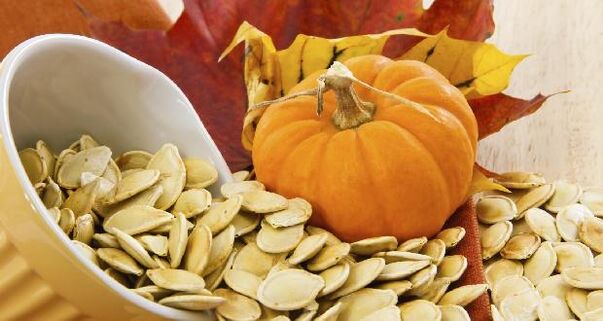
Beetroot and carrot juice, echinacea tincture, helps increase a child’s immunity. Recovery of the nervous system - chamomile tea. Chamomile is also used to enema enterobiasis.
Folk remedies are contraindicated in peptic ulcer, gastritis, inflammation of the pancreas, in children prone to allergies. And of course, before you start testing your "grandmother’s prescriptions" on a child, first consult a pediatrician and a parasitologist, otherwise the outcome of such therapy may be the most unpredictable.
Dietary supplements and homeopathy against worms
The internet is full of advertisements for biologically active additives (BAAs) and homeopathic remedies that manufacturers say completely remove worms. Opinions on the funds are extremely positive.
Why can't a dietary supplement be used to treat worms in children? Biologically active dietary supplements help to normalize metabolism, increase the body's resilience, improve the functioning of internal organs, but do not get rid of parasites. They should only be used with traditional medicines.
Homeopathic preparations consist of a complex of natural extracts. They have no harmful effects on worms either. But they can increase immunity, restore metabolism. Today, many countries prescribe homeopathic medicines because of their ineffectiveness.
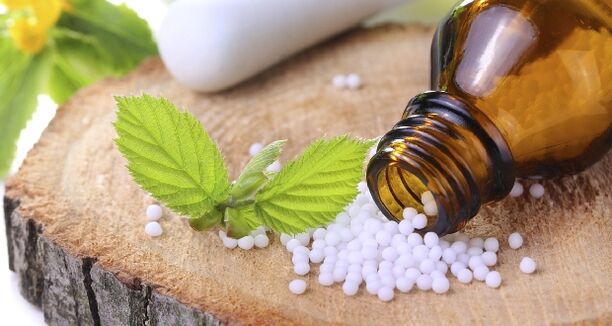
Prevention of helminthiasis in children
Preventing the appearance of helminthiasis in children includes simple measures:
- Hygiene. Parents should ensure that the child washes their hands regularly, takes a bath or shower, does not chew their nails, and does not take toys into their mouths.
- Proper heat treatment of meat and fish.
- Regular scraping of enterobiosis (this procedure is performed in kindergarten).
- Healthy sleep, adherence to daily routine.
- A balanced diet.
- Taking vitamins.
Drug prophylaxis should be performed if cases of infection are registered in a nursery or school, and a member of the family or pet has been infected.
In children, the symptoms of helminths can be easily confused with the manifestations of food poisoning, diseases of the gastrointestinal tract. How to find out if a child has worms, the doctor will tell you. Treatment of worms in children can be performed after an accurate diagnosis has been made and under the strict supervision of a specialist. Caring parents need to understand that the health of young children is entirely in their hands.






































